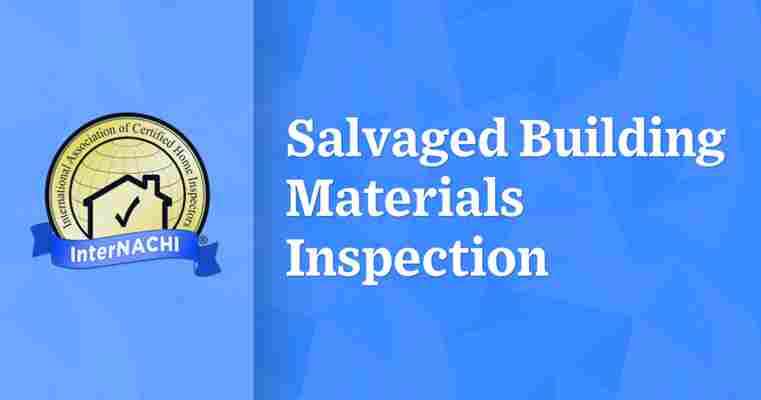January 24,2022
Salvaged Building Materials Inspection
by David Stewart
by Nick Gromicko, CMI®

Salvaged or reclaimed building materials are materials that are recycled for reuse. They originate from buildings that have been deconstructed, rather than demolished. Typically, there is little left that is salvageable after a building has been demolished. When it has been deconstructed, however, there is much that can be reused.
There are two main classifications of materials that are salvaged from deconstructed buildings:
construction materials, such as lumber, steel and bricks; and
appliances and ornamental items that may be fitted into an existing home. Examples include lighting fixtures, bathtubs, sinks, toilets, doors, stained glass, windows, ironwork, kitchen appliances, countertops, fireplaces, molding, flooring, household siding, pipes and insulation.
Salvaged building materials are readily available to the public, according to the U.S. Environmental Protection Agency (EPA), which states, "Nationally, hundreds of building-material reuse stores sell high-quality, salvaged building materials for construction and renovation projects... Materials are salvaged mostly from remodeling projects, pre-demolition salvage, and the growing practice of deconstruction, [which is] the selective disassembly of buildings to reuse and recycle parts. Most stores are open to the public."
Advantages of Using Salvaged Building Materials
The upside of using reclaimed building materials is obvious, including:
the cost savings for homeowners. Reclaimed products are typically substantially cheaper than their new counterparts. This is the case because reclaimed products do not need to be produced and shipped great distances. It is often possible to find building materials at no cost when salvaging from demolition sites;
it's environmentally friendly because it keeps a substantial amount of waste out of landfills. Incredibly, the 170 million tons of waste that accumulate annually due to building construction, renovation and demolition account for nearly 60% of the United States' non-industrial, non-hazardous solid waste, according to the EPA;
it saves the energy and resources that would normally be used for the production of new products;
some reclaimed materials are more valuable than their new counterparts. The primary example of this is wood from old-growth forests, which may be reclaimed from the framing of older buildings. Such wood is highly valuable because it is of superior quality compared to some new wood due to its fine grain and lack of knots, as well as its aged appearance; and
many salvaged ornamental items are valuable for their historical significance and beauty.
Limitations of Using Salvaged Building Materials
The selection of salvaged materials is not predictable.
Salvaged lumber may need to be de-nailed and re-milled in order to bring it up to code with today's sizing standards.
Some reclaimed items may be more expensive than their newer counterparts (either reproductions or updated versions), such as antique fixtures and hard-to-find hardware.
Salvaged wood may be coated with lead-based paint (LBP). Lead is extremely toxic and no longer legal to use in the manufacture of house paint in the U.S.
Salvaged bricks may be of different qualities, since older techniques used varying temperatures and consistencies.
Roofing materials oftentimes cannot be reclaimed because of their short lifespans.
Old electrical appliances may not be salvageable because they do not meet current guidelines for safety or energy efficiency.
Older toilets may use an excessive amount of water compared to today's low-flow units, and installing them may be counter to local building codes or HOA guidelines.
Windows may be prohibitively energy-inefficient.
Salvaging building materials may be illegal, depending on local ordinances.
Potential Hazards and Inspection
Reclaimed lumber may have a wood grading that is expired or illegible.
All reclaimed materials that are to be used as structural supports should be inspected by a qualified professional and deemed safe prior to use.
Salvaged bricks should always be tested for durability prior to use. Inspectors may want to make sure that brick surfaces are relatively even.
Lumber from homes built up until the late 1970s may contain LBP. Such wood should be used in limited circumstances, and exposed materials should never be sanded.
Old plumbing may also contain lead. These should not be salvaged, since lead can leach into drinking water from pipes.
Salvaged materials from older buildings may contain asbestos, which can be extremely hazardous. A professional qualified in safe asbestos removal should be contracted whenever the presence of asbestos is suspected.
Extreme caution should be used when salvaging electrical appliances, as they are liable to have damaged or faulty wiring.
Old lighting fixtures that may contain polychlorinated biphenylsor or mercury, which are highly toxic, should be avoided.
Salvaged fire doors may pose a fire hazard if they are not up to current fire safety standards.
Local ordinances should always be followed with respect to the legality of salvaging and building with reclaimed materials.
In summary, utilizing reclaimed building materials is a potentially cost-saving and environmentally responsible undertaking, but extreme caution must be used when salvaging certain items.






